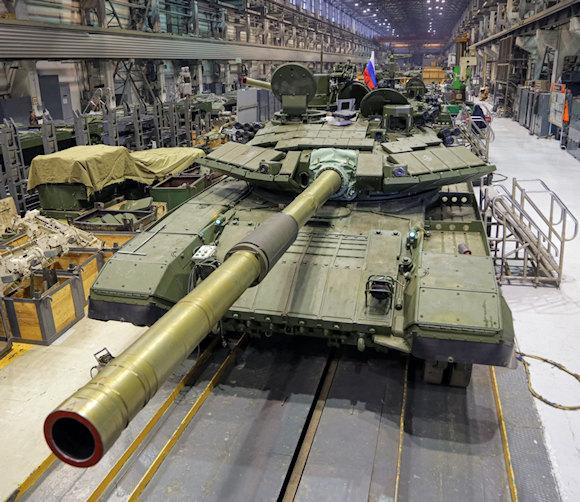I want to introduce this analysis of Russian war production after two years of commitment in the conflict with Ukraine, starting from the weapons system which in the scenarios of modern warfare par excellence is associated with field battles: the tank.
At the end of 2023 Russian tank factories recorded a decrease in the delivery rate of their products and, however, maintained a ratio three times higher than that of tanks delivered by Western industries.1 In 2023, in fact, the Uralvagonzavod , Omsktransmash - branch of Uralvagonzavod since 2004 -2 they delivered over 500 tanks, of the T-90M, T-72B3M, T-80BVM and T-62M types. Although half of these tanks are made up of old T-62Ms, the quantity indicates the ability to carry out deliveries with a certain continuity and, therefore, a relative ability to make up for losses and meet the needs on the front.
La Omsktransmash it initially aimed to deliver 180 units by December, but managed to get it up to 120 units. Although the factory has the capacity to produce 400 tanks on an annual basis, it has faced several problems, especially regarding the production of the guns for the tanks.
At present, there are only two factories producing steel blanks and one factory producing tank guns. The armaments components factory Motovilikha is being expanded, but it will take a few more months to increase production. Even the largest Uralvagonzavod of Omsk recorded a decrease in deliveries. The company made deliveries in January, July and October, totaling approximately 120 to 140 tanks, consisting of the T-90M and T-72B3M variants. Then there's the production of the 103rd Armored Vehicle Repair Plant, responsible for the T-62M, which ended the year with over 250 tanks delivered.
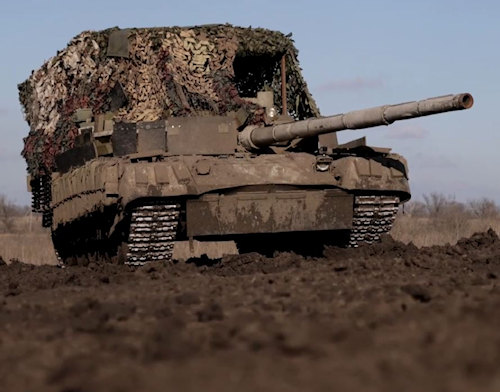 More than on the "modernization" of the T-62 tanks,3 I want to focus on T-80BVM (photo) and on some details relating to the latest generation T-90M tanks Proryv-3 and T-14 Armata, interesting for the implications related to the supply of components and the circumvention of the international sanctions imposed on Russia.
More than on the "modernization" of the T-62 tanks,3 I want to focus on T-80BVM (photo) and on some details relating to the latest generation T-90M tanks Proryv-3 and T-14 Armata, interesting for the implications related to the supply of components and the circumvention of the international sanctions imposed on Russia.
Aleksandr Potapov, CEO of Uralvagonzavod SpA, he told the television channel Zvezda, that the production of the T-80s had to be totally renewed: “This is our task (to produce T-80 tanks), the military assigned it to us. And now we are actively studying the problem with the Ministry of Industry and Trade, because this requires new production capacities"4
Let's see what the main features of this tank are. A TASS press release from December 2018, reporting a bulletin from the Russian Ministry of Defense, announced that the new version of the T-80 had been modified to be able to fire depleted uranium ammunition, like many latest generation tanks.
Again citing the bulletin, the Russian news agency reported that the T-80BVM presents “an improved weapon stabilizer and loading mechanism for 3BM59 (Svinets-1) and 3BM60 (Svinets-2) ammunition”.5 The armor-piercing projectile Svinets-1 has a tungsten carbide core while the Svinets-2 has a uranium alloy core. The Svinets-1 it is capable of piercing 700-740 mm of tank armor at a distance of 2 km while the Svinets-2 can pierce 800-830 mm at the same distance. This capability assumes importance in light of the United States' decision to supply Ukraine with depleted uranium shells that can penetrate the armor of tanks and set them on fire due to the intense heat they generate.
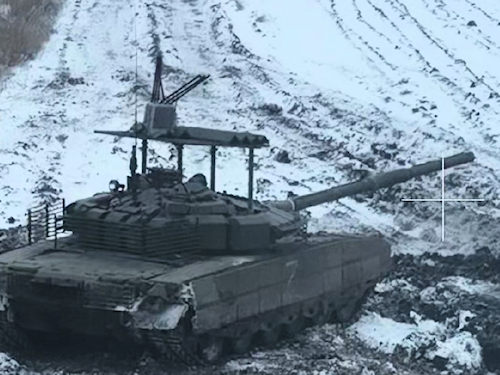
The T-80BVM is the most updated version of this tank and has been further improved based on combat experience gained in Ukraine. This is the T-80 BVM Obr.2023, presented on 10 September 2023,6 and characterized, first of all, by a roof placed above the turret, as protection against the ammunition that could hit it from above. It also features greater armor protection, with new reactive grilles on the sides.
Another important addition is the placement of two electronic anti-drone jammers Volnorez, with two omnidirectional antennas. These antennas have a magnetic base, which allows them to be mounted without structural modifications. They have an effective suppression radius of 1 km.
Another change is the rework of the transmission, which allows a reverse speed of over 20 km/h, faster than previous variants.
In general, the T-80BVM is considered one of the fastest tanks in the world.
So far the Russian Armed Forces have received around 500 T-80 tanks of the old generation, modernized to the T-80BVM standard.7
Now, it is appropriate to make some considerations. There Uralvagonzavod has not produced a new T-80 hull since 1991.8 While the Omsk factory may still have equipment dating back more than three decades, it may face problems sourcing the tens of thousands of components needed to assemble a new T-80.
At the dawn of two years since the beginning of the invasion, Russia is estimated to have lost over 4.000 tanks.
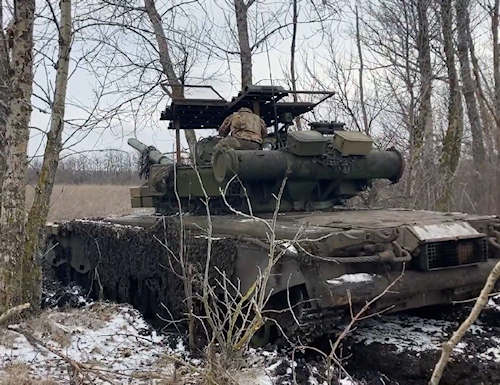 It is a fact that the Russian armaments use policy envisages using all available resources, including the most obsolete, such as the thousands of vehicles stored in vehicle fleets since the Cold War. Among these, we find hundreds of T-80s dating back to initial production. It is also true, however, that the availability of stored tanks is not unlimited. Ultimately, the Uralvagonzavod put the innovative T-80BVM into production by applying more modern targeting and fire control systems to pre-1991 hulls.9
It is a fact that the Russian armaments use policy envisages using all available resources, including the most obsolete, such as the thousands of vehicles stored in vehicle fleets since the Cold War. Among these, we find hundreds of T-80s dating back to initial production. It is also true, however, that the availability of stored tanks is not unlimited. Ultimately, the Uralvagonzavod put the innovative T-80BVM into production by applying more modern targeting and fire control systems to pre-1991 hulls.9
Be it the T-80BVM or the T-80BV Obr. 2023, a totally revamped production line for these tanks may require the intervention of hundreds of subcontractors who have not built tank parts for more than three decades. This is why Potapov emphasized the need for “new capabilities”.
The investigations available on open sources can sometimes be of great interest and full of details. This is the case of an article published on the site The Insider,10 relating to the technological contribution in the armaments sector provided to Russia by numerous states, despite the sanctions and in this case not attributable to the countries that traditionally gravitate in the Kremlin's orbit (with the exception of Serbia), which I have discussed in my previous articles .11 Believing that the degree of reliability of the source and truthfulness of the news, in this specific case, are of a good level, I report what essentially emerges from this investigation.
Let's start with Italy. I said about Uralvagonzavod, Company leader in Russia regarding the design and production of tanks, howitzers and other armored vehicles and equipment. I also mentioned Alexander Potapov, who has led the company for the past six years, a former government official and member of Vladimir Putin's United Russia party. Before taking over as CEO, he worked for the Russian government and the Federal Defense Contracting Service (Rosoboronzakaz).
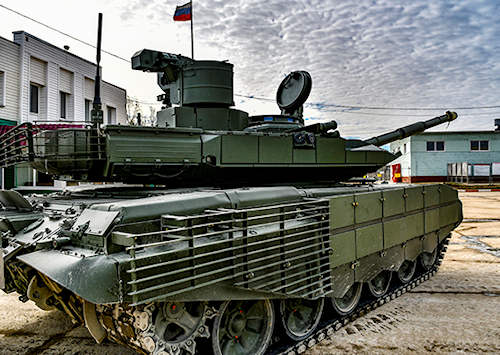 During the period in which he was deputy head of the Russian Ministry of Industry and Trade, a position that placed him in charge of the military-industrial complex, his daughter Polina attended the course of Fashion Marketing at the prestigious Istituto Marangoni in Milan (2016). At this point it is legitimate to ask what this has to do with Moscow's war industry. It is about highlighting the bond that the Russian oligarch-entrepreneur has established with our country, to the point of establishing agreements with Italian companies that have become suppliers and subcontractors of the Uralvagonzavod regarding the production of tanks.
During the period in which he was deputy head of the Russian Ministry of Industry and Trade, a position that placed him in charge of the military-industrial complex, his daughter Polina attended the course of Fashion Marketing at the prestigious Istituto Marangoni in Milan (2016). At this point it is legitimate to ask what this has to do with Moscow's war industry. It is about highlighting the bond that the Russian oligarch-entrepreneur has established with our country, to the point of establishing agreements with Italian companies that have become suppliers and subcontractors of the Uralvagonzavod regarding the production of tanks.
The main battle tank rolled off the assembly line Uralvagonzavod it is the T-90M Proryv-3, which entered service in April 2020 at the armored division Garden'.12
Il Proryv-3 It is equipped with a targeting system Sosna-U (also present on the T-80BVN), developed by designer Belarusians. However, due to various agreements, the sight is produced in Russia by the Vologda optical and mechanical plant VOMZ SpA, which is part of the Shvabe Holding, owned by the Rostec State Corporation.
According to public procurement data, the supplier of metalworking lathes to VOMZ is PIK Fine selection SpA, which also works for other companies owned by Rostec. The Fine selection receives spare parts for machine tools from the Italian company MT srl of San Giovanni in Marignano, in the province of Rimini.
Another company contracted by the Defense is the Pumori-North-West srl of St. Petersburg, which supplies machine tools for metalworking to both VOMZ and Tactical Missile Armament Corporation. In January 2023 this year the company imported a shot blasting machine sold by Norblast srl of Bologna.
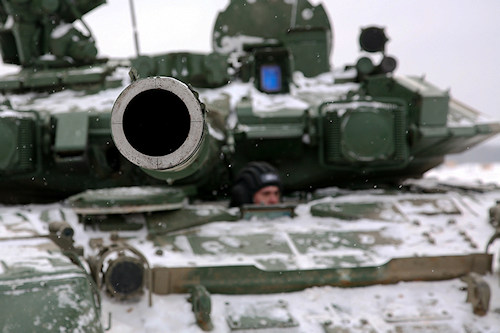 Since the beginning of the invasion of Ukraine, the Pumori-North-West purchased steel needles, filter cartridges, valves shut-off, polymer rings and other components from CMSSpA (based in Zogno, Bergamo).
Since the beginning of the invasion of Ukraine, the Pumori-North-West purchased steel needles, filter cartridges, valves shut-off, polymer rings and other components from CMSSpA (based in Zogno, Bergamo).
In December 2022, Devco SRL of Paderno Dugnano (Milan) supplied the company with milling machines for metalworking, for a value of 50.000 euros. Furthermore, the Russian Ministry of Defense purchased an automatic washing machine for metal products from the Magido Group of Trezzano sul Naviglio, another municipality in the Milan area.
Even companies from the Baltic countries, despite these states' aversion to Russia, are often involved in logistics and transport services, delivering products from European companies to Russian defense companies. Particularly active in this sense is theEstonia. For example, the Gold Solution OU , Leolart.com transport Italian goods from Tallinn destined for Pumori-North-West, While the Alekon OU provides warehousing services.
La Sumar Tools OU supplies casting models and self-produced molds to Invest Stanko Ltd. in Khimki, Moscow region. This company, in turn, supplies machine tools to Zavod No. 9 SpA a subsidiary of Rostec responsible for the production of tank guns. Its main products include T-72 and T-90 tank guns.
There have also been reports of cannon production for the T-14 Armata (following photo), but so far this much-hyped tank seems more like a propaganda item than a real asset.13
La Elsorel OU supplies glue, glass textolite panels, organic decomposition lamps, aluminum nitrate and semi-finished silver to Proton-Elektrotex of Orel. The company is part of AO Proton, one of the leading optoelectronics manufacturers in Russia. The work of Proton for the country's Defense industry is evident on its website websites. His partners include Rostec, Almaz-Antey e Tactical Missile Armament Corporation.
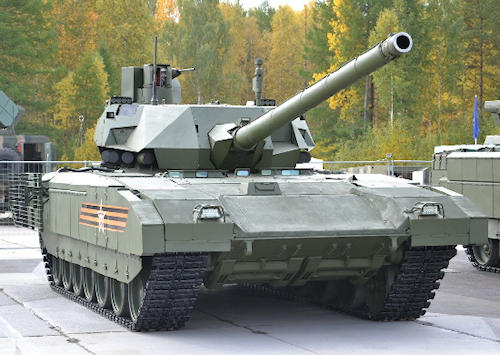
The CEO of Proton, Vyacheslav Menshov, was awarded a medal for his “assistance to the special military operation”. Nonetheless, nothing stopped Estonian businessmen from continuing to trade with Proton during the war. State procurement data shows that the Proton It provides microchip to VOMZ (which produces targeting systems for tanks) and many other companies in the Defense sector. The company's total portfolio of government contracts exceeds 2,8 billion rubles (about $31 million). The company is not yet on the European Union sanctions list, while it has already been sanctioned by the United States.
The company too Finnish Meconet OYFurthermore, during the war it supplied copper wire and parts of semiconductor devices to the Proton-Elektrotex. The representatives of the Meconet they explained that the shipment of the goods to Russia six months after the full-scale invasion of Ukraine was due to the fact that the tools belonged to their former Russian partners and had to be returned: “Our disengagement from the Russian market began in March 2022 and was fully realized in August 2022. Furthermore, the customer-owned tools, which were in our possession, were lawfully returned to him in August 2022, subject to final agreement. It is important to note that we were legally obligated to return these items that were not ours".
With regard to the Latvia, until its recent liquidation, the Baltic Machinery, based in Riga, supplied seals O-ring, joints and other Russian-style artifacts unimatic. The unimatic It is owned by Oleg Fishelev. The shares were transferred to him in 2018 by his father, Igor Fishelev, who has since become chairman of the company's board of directors. Igor Fishelev is the owner of Arpack UK Limited in London. He was granted British citizenship in 2022, in the aftermath of Russia's invasion of Ukraine. There unimatic of the Fishelev family does not only work for the Zavod No. 9, but also for other defense companies, including the Verkhneturinsk machine-building factory, which produces grenade casings for field artillery and tanks. Always there unimatic receives washers and caps for lathes of Austrian origin through the Lithuanian company UAB Elfanta which, when questioned on the merits, limited itself to underlining that it is a warehousing and customs documentation company and that it does not collect any data on who the recipient of the goods is.
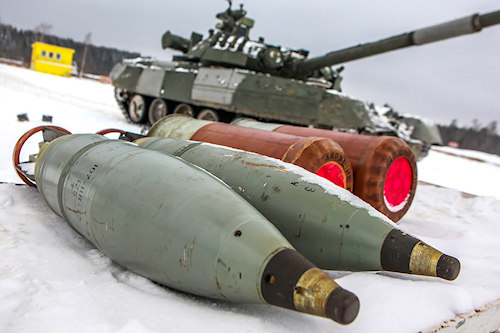
In Lithuania the customs warehouse was also used UAB Didneriai in Vilnius, to facilitate trade with Russia.
I mentioned theAustria, let's see, then, how it is involved in military trade with the Russian Federation. One of the most important suppliers of unimatic and, consequently, of the manufacturer of tank guns Zavod No. 9, and the EMCO GmbH by Hallein. The company exports rotating pulleys and brackets, locking rings, timing belts and, of course, machine tools. There EMCO GmbH , unimatic they have collaborated for many years. They even created one j: The company is operational in Yekaterinburg Emco-Rus, of which the EMCO GmbH holds 65% and unimatic the 35%.
Let's get to the Germany. The German company WTO Werkzeug-Einrichtungen GmbH is a supplier to several Russian defense companies. Send lathe components to OTC-Technologies in the Sverdlovsk region, which then sells tools to Zavod No. 9 and Uralvagonzavod. The WTO Werkzeug-Einrichtungen also supplies its products to the omnipresent unimatic. Always there WTO Werkzeug-Einrichtungen supplies tool holder sets to TD SMS srl, based in Penza, which is connected to Stankomashstroy srl, supplier of machine tools to Rostec. He's from La Stankomashstroy it is owned by Oleg Kochetkov, United Russia deputy in the Legislative Assembly of the Penza region. Then, in November 2023, the Oxapa GmbH of Jena, a company owned by the Belarusian Vladislav Matusiewicz, supplied raw glass for optical processing to NPK Macrooptika Ryazan Ltd. There Macrooptika is a leading Russian manufacturer of opto-mechanical systems for aircraft and military equipment, as well as a contractor of VOMZ and other subsidiaries of Rostec, as well as the FSB, the Ministry of Defense and the Tactical Missile Armament Corporation. Despite these precedents, the NPK Makrooptika it has so far only been sanctioned by Ukraine.
Finally, a mention for the Rudi Gebel Gmbh & Co. Kg of Helmbrechts, Bavaria, which sells components for the assembly of semiconductor power electronic devices to the aforementioned Proton which, as mentioned, supplies optoelectronics to military companies.
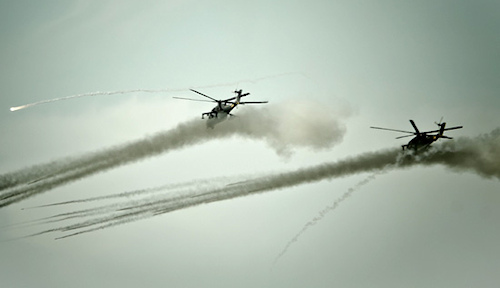 Let's come to Asia. About the South Korea, Mabuchi Korea Corporation, based in Seoul, supplies machine tool oil, lens grinders, optical polishing powder and other goods to the aforementioned NPK Macrooptika. Deliveries began in January 2023.
Let's come to Asia. About the South Korea, Mabuchi Korea Corporation, based in Seoul, supplies machine tool oil, lens grinders, optical polishing powder and other goods to the aforementioned NPK Macrooptika. Deliveries began in January 2023.
La Seolin Industry Inc., also from Seoul, supplies solvents, paints and other products to Elekund SpA in the Republic of Udmurtia, one of the companies leader of the Russian military-industrial complex in the development and production of electrolytic capacitors. The company also has contracts with VOMZ.
Il Japan, in turn, has solid ties with the Elekund: the Japan Industrial Trading exports rubber gaskets and cathode sheets and the Kaga Electronics supplies it with ready electrolytes for the production of capacitors. The representatives of Japan Industrial Trading they were keen to point out that their company is a Japanese trading company that strictly complies with all trade regulations and sanctions introduced by their country's government. Furthermore, it has nothing to do with any company mentioned in the sanctions list of theOffice of Foreign Assets Control (OFAC) of the United States or with controlling shareholders included in that list. The only country that has imposed sanctions on Elekund It's Ukraine. This means that Japanese companies can actually trade with the Russian defense contractor. The president of Elekund is Anatoly Naumov, head of the United Russia party in the State Council of the Republic of Udmurtia. This year he was awarded theOrder of Merit for the Fatherland, in recognition of his “support for fighters” during the invasion of Ukraine.
- United Statesfinally, although they are among the most prolific sanctioners of Russian companies and those connected to them, they have companies that still maintain commercial relationships with companies linked to the Russian defense sector. For example, the Universal Photonics of New York, which exports aluminum oxide and optical polishing powders to NPK Macrooptika and to TPK RZM srl. These Russian companies are both contractors for VOMZ, the tank optics company. Another client company of Universal Photonics and the Morion SpA, which supplies quartz generators for transmitters to the Moscow defense industry.
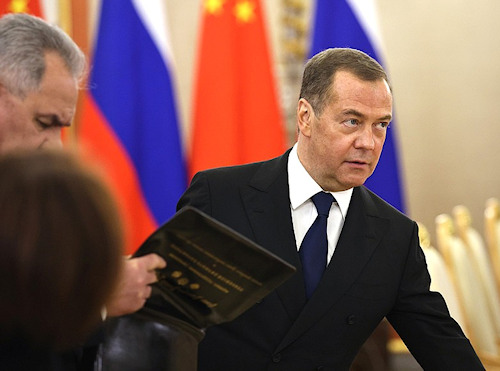 On August 28, 2023, Deputy Chairman of the Russian Security Council Dmitry Medvedev stated on Telegram that Russia produces all types of weapons on its own, even in quantities exceeding the current needs of the Armed Forces.14 However, despite gains in productivity, Russian factories continue to deliver a third of what Medvedev promised in his statement.
On August 28, 2023, Deputy Chairman of the Russian Security Council Dmitry Medvedev stated on Telegram that Russia produces all types of weapons on its own, even in quantities exceeding the current needs of the Armed Forces.14 However, despite gains in productivity, Russian factories continue to deliver a third of what Medvedev promised in his statement.
For the sake of correct information, it should also be said that, in any case, this is still three times more than what Ukraine's supporting countries sent to it in 2023.
Problems affecting tank production also affect other vehicles. The Kurganmashzavod SpA, for example, in the period January - October 2023 delivered only 450-500 vehicles between BMP-3M, BMP3, BMP-2M and BMP-2. Originally, estimates were for 900 units to meet the demand for a 30% increase in production. It is also true that the company produced 50% more than in 2022. Although Russian factories do not operate 24/24, they have hired thousands of workers and increased working hours to to 7 hours a day, 7 days a week, with investments of billions of rubles for expansion, managed mainly by Rostec.15
In summary, while Ukrainian arms deliveries are decreasing, Russian production continues to increase, albeit at a slower pace than expected.
Let us now shift our attention to the evolution of programs for the entry into service of strategic level weapons. In 2018, in his spring speech to the Federal Assembly, Vladimir Putin spoke about Russia's progress in "new weapons", referring notably to intercontinental missile systems, and the Ministry of Defense made statements on missile projects burevestnik, Poseidon, Kinzhal, Avangard, Presvet e Sarmat.16
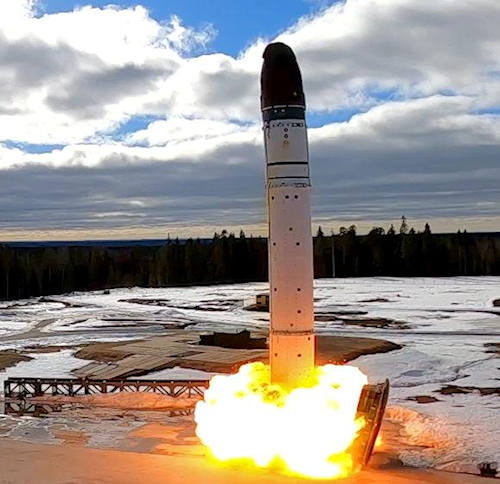 The new RS-28 intercontinental ballistic missile Sarmat (SS-30 Satan 2 in the NATO codification), proudly defined by the Russian media “the most powerful in the world”17 has already been extensively discussed.18 What interests me is the timing of this missile's entry into service. On September 1, 2023, Yuri Borisov, head of the Russian space agency Roscosmos, announced the entry into service of the RS-28 Sarmat19 and, yet, the same agency simultaneously declared that the missile would be operational “the following year,”20 therefore in 2024. As often happens, the truth lies in the middle. Russia has actually completed trials on the Sarmat and will soon move into mass production and combat commissioning, at least according to what Vladimir Putin said:
The new RS-28 intercontinental ballistic missile Sarmat (SS-30 Satan 2 in the NATO codification), proudly defined by the Russian media “the most powerful in the world”17 has already been extensively discussed.18 What interests me is the timing of this missile's entry into service. On September 1, 2023, Yuri Borisov, head of the Russian space agency Roscosmos, announced the entry into service of the RS-28 Sarmat19 and, yet, the same agency simultaneously declared that the missile would be operational “the following year,”20 therefore in 2024. As often happens, the truth lies in the middle. Russia has actually completed trials on the Sarmat and will soon move into mass production and combat commissioning, at least according to what Vladimir Putin said:
""We have actually finished work on the Sarmat, a super heavy rocket. The issue is that we need to complete some procedures at a purely administrative and bureaucratic level,” Putin said at the Valdai Forum."21
The vector Avangard (SS-X-32Zh Scalpel B), hypersonic reentry vehicle with a gliding wing unit, however, has already been put into serial production. In December 2019, the 621st Missile Regiment,22 stationed in Dombarovsky, part of the 13th "Red Flag" missile division of Orenburg, it was the first regiment to be equipped with the Avangard. In December 2021, the rearmament of this regiment was completed, bringing the number of RS-6 (SS-18) missiles to 19 Stiletto Mod 4) equipped with theAvangard hypersonic glide vehicle (HGV) system, following an installation rate of two systems per year for the modernization of these units. 23
The first missile of a second regiment, the 368th Dombarovsky Missile Regiment, was loaded into its silo in December 2022. The upgrade of this unit is aimed at having a total of 12 silos (two regiments) operational by 2027.24 At the end of 2022, seven missile systems were in service Avangard.25 The procurement of these missile systems continued throughout 2023, as widely reported in the Russian media.26 At the end of 2023, according to a statement by Russian Defense Minister Sergei Shoigu, the Strategic Missile Forces would have completed the re-equipment with the system Avangard.27 In reality, it is not clear what stage the rearmament program with this weapons system is at.
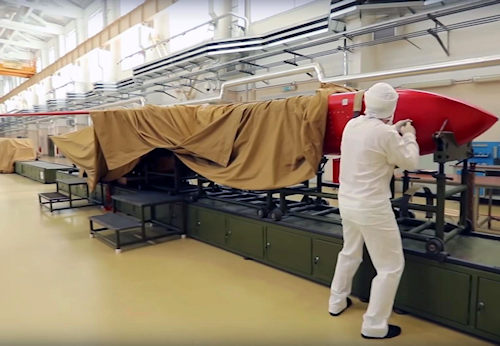 Unlike the other missiles I have discussed, the development program for the 9M730 would be suspended burevestnik (SSC-X-9 Skyfall, Also known as Petrel), a cruise missile which, thanks to a nuclear propulsion system, is believed to have a virtually unlimited range. The existence of the creation of burevestnik it dates back to March 18, 2018, when Putin spoke about it during a speech to the Federal Assembly.28 However, the tests conducted on the missile began two years earlier and, since then, they have continued with a series of serious setbacks: according to US military intelligence, the testing failed a dozen times, starting from June 2016. The NGO is more precise Nuclear Threat Initiative, according to which from 2017 to 2019 Russia conducted 13 missile tests, all unsuccessful.29 In November 2017, a failed test resulted in the loss of the missile at sea, requiring a significant recovery effort. In August 2019, after another launch failure, another recovery attempt resulted in an explosion resulting in an unknown number of casualties (5 to 7, according to different sources) at the Nënoksa missile test site (oblast' of Arkhangelsk).30 The explosion indicated by the United States as a consequence of the fall of the missile, is attributed by the Kremlin to a liquid fuel jet engine that some scientists were working on.31 There have been no declared tests of the system since 2019, and unlike other elements of Russia's nuclear forces, it has not been mentioned by high-profile Russian officials since then. In August 2021, satellite imagery appeared to indicate that Russia was preparing for another test of the system burevestnik to the Novaya Zemlya site; however, it seems unlikely that a test ever took place.32 We arrive at October 2023, when the New York Times reported that President Putin declared a successful missile launch, without specifying when; after studying satellite images and aerial data of movements in the Novaya Zemlya archipelago, the newspaper came to the conclusion of carrying out the test. Moscow was quick to deny any testing of the missile in the indicated period.33 If not suspended, the start of large-scale production of the Petrel it has certainly slowed down.
Unlike the other missiles I have discussed, the development program for the 9M730 would be suspended burevestnik (SSC-X-9 Skyfall, Also known as Petrel), a cruise missile which, thanks to a nuclear propulsion system, is believed to have a virtually unlimited range. The existence of the creation of burevestnik it dates back to March 18, 2018, when Putin spoke about it during a speech to the Federal Assembly.28 However, the tests conducted on the missile began two years earlier and, since then, they have continued with a series of serious setbacks: according to US military intelligence, the testing failed a dozen times, starting from June 2016. The NGO is more precise Nuclear Threat Initiative, according to which from 2017 to 2019 Russia conducted 13 missile tests, all unsuccessful.29 In November 2017, a failed test resulted in the loss of the missile at sea, requiring a significant recovery effort. In August 2019, after another launch failure, another recovery attempt resulted in an explosion resulting in an unknown number of casualties (5 to 7, according to different sources) at the Nënoksa missile test site (oblast' of Arkhangelsk).30 The explosion indicated by the United States as a consequence of the fall of the missile, is attributed by the Kremlin to a liquid fuel jet engine that some scientists were working on.31 There have been no declared tests of the system since 2019, and unlike other elements of Russia's nuclear forces, it has not been mentioned by high-profile Russian officials since then. In August 2021, satellite imagery appeared to indicate that Russia was preparing for another test of the system burevestnik to the Novaya Zemlya site; however, it seems unlikely that a test ever took place.32 We arrive at October 2023, when the New York Times reported that President Putin declared a successful missile launch, without specifying when; after studying satellite images and aerial data of movements in the Novaya Zemlya archipelago, the newspaper came to the conclusion of carrying out the test. Moscow was quick to deny any testing of the missile in the indicated period.33 If not suspended, the start of large-scale production of the Petrel it has certainly slowed down.
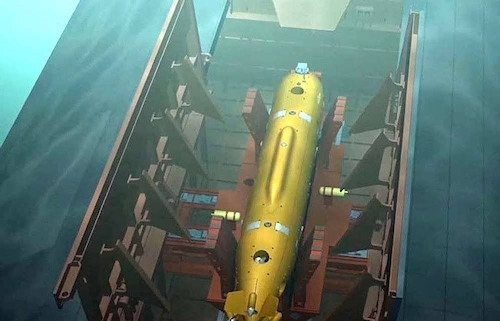 In January 2023, Russian news agency TASS reported that Russia had produced the first batch of nuclear-powered, long-range, nuclear-armed torpedoes, called Poseidon. It is not known how many there are.34 The torpedo, a nuclear-powered underwater drone equipped with nuclear warheads, is designed to be launched from submarines. The torpedo, also known in the United States as Kanyon, Ocean Multifunction System e Status-6, was revealed by the Russian Navy in 2015 and was reportedly first tested in November 2016.35 The first Poseidon It is expected to enter service by 2027.36 Particularly devastating would be the torpedo's payload: a nuclear warhead with a probable yield of several megatons, apparently up to 100. For comparison, the Tsar Bomba Russian nuclear weapon, the most powerful ever tested, had an estimated explosion power of about 50 megatons.37 The outcry aroused by the devastating power of this weapon initially led some observers to consider the Poseidon Russian as a propaganda initiative rather than a real threat;38 today this is no longer the case and this project has received significant resources from the Russian military, although many details remain unknown. Intelligence reports39 suggest that the Poseidon has been subjected to many tests; in support of this thesis there would be the fact that some submarines have been modified and some have been built specifically to accommodate the largest and heaviest torpedo of those in service so far. For example, it is believed that the Sarov submarine was modified to test prototypes of the Poseidon.40 The original plan was that the Russian Navy intended to purchase at least 30 torpedoes Poseidon and deploy them on four submarines: two on Northern Fleet submarines and two on Pacific Fleet submarines.41 It would appear that the program is slowly progressing as planned.
In January 2023, Russian news agency TASS reported that Russia had produced the first batch of nuclear-powered, long-range, nuclear-armed torpedoes, called Poseidon. It is not known how many there are.34 The torpedo, a nuclear-powered underwater drone equipped with nuclear warheads, is designed to be launched from submarines. The torpedo, also known in the United States as Kanyon, Ocean Multifunction System e Status-6, was revealed by the Russian Navy in 2015 and was reportedly first tested in November 2016.35 The first Poseidon It is expected to enter service by 2027.36 Particularly devastating would be the torpedo's payload: a nuclear warhead with a probable yield of several megatons, apparently up to 100. For comparison, the Tsar Bomba Russian nuclear weapon, the most powerful ever tested, had an estimated explosion power of about 50 megatons.37 The outcry aroused by the devastating power of this weapon initially led some observers to consider the Poseidon Russian as a propaganda initiative rather than a real threat;38 today this is no longer the case and this project has received significant resources from the Russian military, although many details remain unknown. Intelligence reports39 suggest that the Poseidon has been subjected to many tests; in support of this thesis there would be the fact that some submarines have been modified and some have been built specifically to accommodate the largest and heaviest torpedo of those in service so far. For example, it is believed that the Sarov submarine was modified to test prototypes of the Poseidon.40 The original plan was that the Russian Navy intended to purchase at least 30 torpedoes Poseidon and deploy them on four submarines: two on Northern Fleet submarines and two on Pacific Fleet submarines.41 It would appear that the program is slowly progressing as planned.
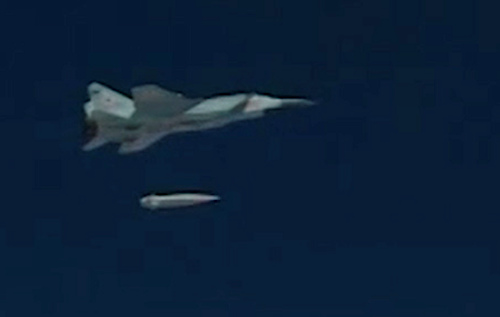 A few words on the developments in the use of the hypersonic missile Kinzhal, which has been in service since the end of 2021 and for the use of which a separate air regiment of MiG-31K fighters was specially established.42 An interesting technical fact concerns the statement by the Russian authorities according to which the missile, from the moment of its launch from the carrier, would fly at a speed greater than 10 times the speed of sound. This feature would allow it to evade all existing air and missile defense systems. Actually, on May 4, 2023 a system Patriot of the Ukrainian armed forces managed to shoot down a Kinzhal and, according to one of the operators on the air defense system, the speed in the terminal section of the missile's trajectory was 1240 m/sec (~3 M ), so - three times less than the 10 M declared by representatives of the Russian Federation43
A few words on the developments in the use of the hypersonic missile Kinzhal, which has been in service since the end of 2021 and for the use of which a separate air regiment of MiG-31K fighters was specially established.42 An interesting technical fact concerns the statement by the Russian authorities according to which the missile, from the moment of its launch from the carrier, would fly at a speed greater than 10 times the speed of sound. This feature would allow it to evade all existing air and missile defense systems. Actually, on May 4, 2023 a system Patriot of the Ukrainian armed forces managed to shoot down a Kinzhal and, according to one of the operators on the air defense system, the speed in the terminal section of the missile's trajectory was 1240 m/sec (~3 M ), so - three times less than the 10 M declared by representatives of the Russian Federation43
Laser systems for air defense and combat missiles Presvet they are already operational at the 14th Missile Division of Yoshkar-Ola, the 35th Missile Division of ZATO Sibirsky, the 39th Guards Rocket Division of Novosibirsk and the 54th Guards Missile Division of Tevkovo.44 Of note, the criticism raised by the expert Igor Korotchenko of the Center for the Analysis of the Global Arms Trade, who stated that this system (and in general all laser systems) are effective if used in favorable climatic conditions, that is, in absence of precipitation, fog, sandstorms, particularly due to the shooting down of drones.45
Staying on the topic of the ability to intercept and shoot down adversary drones, I was intrigued by a post of the milblogger Russian Boris Rozhin on Telegram. This is a technical analysis carried out by ONLUS Dvina, a company specialized in the production of security systems, electronic communications, drones and optical systems.46 Below is the translation:
“We are often asked whether the ONLUS Dvina can provide some kind of solution that would allow not only to detect and, with varying degrees of success, suppress enemy UAVs, but in general to preclude them from using airspace. Yes, there is such a solution. It can be called 'advanced small air defense'. Let's calculate how much a front-line mobile robotic platform for drone detection and destruction would cost:
1. mobile chassis up to 2 tons - about 3 million rubles;
2. UAV detection radar type DIVITEC DT-RD3000 - about 7 million rubles;
3. multispectral channel – about 5 million rubles;
4. multi-frequency suppression channel – about 3 million rubles;
5. destruction channel 2 x GShG-7.62 – approximately 2 million rubles;
6. avionics: about 2 million rubles;
7. broadband secure control channel – about 2 million rubles;
8. operator base station – about 3 million rubles;
9. assembly - 4 million rubles;
10. Experimentation - about 3 million rubles.
TOTAL: approximately 34 million rubles (over 350.000 euros, editor's note) for an installation, which within a radius of 1,5 km, is capable of shooting down everything that has an ESR of at least 0,01 and does not fly faster of 50 m/s. If desired, the parameters of the detected and shot down targets can be increased by the order of magnitude, but the costs inevitably grow. Therefore, there are no problems in the creation of such devices. All necessary components for such systems are available in Russia. The question to ask is different, everything can be done, but who will pay for this research...?”47
Taking these considerations with benefit of inventory, the fact remains that, as regards the command of the air, two years after the beginning of the invasion and despite the efforts made, Russia is still encountering significant difficulties and the technology to tackling them requires a significant economic effort for Moscow also in this respect.
 Let's stay in the field of drones and see what the Kremlin's needs are that have required an innovative contribution in this sector, even if I will deal with the now famous Shahed 136 o Geran-2, in the name given by the Russians. Beyond the controversy over whether the drones used by Moscow in Ukraine come from Iran or are of Russian production, it is a fact that this weapon is protected by high standards of confidentiality to protect the technical characteristics that determine its effectiveness.48 However, some technical data on the evolution of this product is available.49
Let's stay in the field of drones and see what the Kremlin's needs are that have required an innovative contribution in this sector, even if I will deal with the now famous Shahed 136 o Geran-2, in the name given by the Russians. Beyond the controversy over whether the drones used by Moscow in Ukraine come from Iran or are of Russian production, it is a fact that this weapon is protected by high standards of confidentiality to protect the technical characteristics that determine its effectiveness.48 However, some technical data on the evolution of this product is available.49
Presented to the public for the first time in 2021, these drones are designed to destroy ground targets very distant from the launch site. Let's move on to the technological elements. This drone was initially designed with a one-piece fuselage. It is currently produced in a modified version whereby the UAV has a composite structure. The marking (series and character) has also been changed. In the original version of Shahed 136 the fuselage filling was honeycomb molded; in the latest version, however, it features padding similar to polyurethane assembly foam. The main objective of this replacement is the reduction of the production costs of the drone and the possibility of starting its mass production.
Another characterizing element is the presence of digital antennas of the type Kometa, for satellite navigation receivers designed to reduce enemy jamming capability. These antennas are also mounted in the Russian UAV Orlan-10 and in the latest generation FAB-500 glide bombs, equipped with the UMPK system (Unifitsirovannogo nabora Modulei Planirovanie i Korrekcii - Unified set of modules for planning and correction). The previous Shahed 136 it contained a battery made up of 18650 Li-Ion accumulators; in the latest version it is equipped with a Russian helium battery Delta Battery. Regarding armament, according to Ukraine, the new Shahed-136 drones have a warhead filled with tungsten spheres. Ultimately, the differences presented aim to achieve the reduction of production costs of the Shahed 136/Geran-2. It is important to note that the replacement of components in the Shahed 136/Geran-2 can be an indicator of both the effectiveness of foreign sanctions and the intention to unify Russian UAV production.
Meanwhile, Russian industry continues to fulfill production orders for the necessary weapons and equipment, including attack UAVs. Have an ample supply of shahed-136, allows Russia to continue with air strikes against Ukraine beyond the front line without employing its remaining short-range cruise and ballistic missiles. Not to mention the advantageous cost-benefit ratio, compared to the anti-aircraft defenses that Ukraine must use to shoot them down.
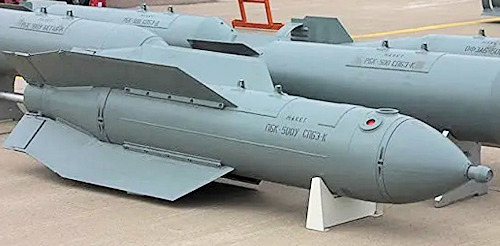 I conclude with some data on the production of glide bombs, of which Moscow has put a new type into production: the glide bomb drel which recently passed all the experimental phases. There Rostec, announced that it will begin mass production of the new bomb this year; warheads are also under development.50 Work on the new glide bomb was first announced in 2016 and is expected to be virtually undetectable on radar. The device is designed to destroy armored vehicles, ground radar stations, power plant control centers and anti-aircraft missile systems.51 Media sources report that the bomb is loaded with cluster munitions.52 It must also be said that the capabilities of cluster in a glide bomb they are not a novelty in the Russian arsenal. A late November 2023 update from British intelligence reported that there was a realistic possibility that Russia had integrated glide kits with the 500-pound RBK-1.100 cluster bomb, as it had done with other aerial munition.53 In early December, analystsInstitute for the Study of War they stated that Russia was increasingly relying on glide bombs to hit Ukrainian targets.54 But a few weeks later, they wrote that Moscow had reduced its use of bombs after Kiev shot down several Russian warplanes, particularly Su-34 fighter-bomber planes. Russian forces reportedly use glide bomb attacks so that Russian planes can remain 50 to 70 kilometers behind the battle line.55
I conclude with some data on the production of glide bombs, of which Moscow has put a new type into production: the glide bomb drel which recently passed all the experimental phases. There Rostec, announced that it will begin mass production of the new bomb this year; warheads are also under development.50 Work on the new glide bomb was first announced in 2016 and is expected to be virtually undetectable on radar. The device is designed to destroy armored vehicles, ground radar stations, power plant control centers and anti-aircraft missile systems.51 Media sources report that the bomb is loaded with cluster munitions.52 It must also be said that the capabilities of cluster in a glide bomb they are not a novelty in the Russian arsenal. A late November 2023 update from British intelligence reported that there was a realistic possibility that Russia had integrated glide kits with the 500-pound RBK-1.100 cluster bomb, as it had done with other aerial munition.53 In early December, analystsInstitute for the Study of War they stated that Russia was increasingly relying on glide bombs to hit Ukrainian targets.54 But a few weeks later, they wrote that Moscow had reduced its use of bombs after Kiev shot down several Russian warplanes, particularly Su-34 fighter-bomber planes. Russian forces reportedly use glide bomb attacks so that Russian planes can remain 50 to 70 kilometers behind the battle line.55
It would appear that the losses suffered by the Russians have caused some concern in the Kremlin and, again, Ukrainian air defense capabilities do not allow Russian forces to have total control of the airspace.
1 Patricia Marins, 02/11/2023. https://twitter.com/pati_marins64/status/1719943241385001365.
2Конструкторское бюро "Омсктрансмаша" as "Уралвагонзав ода" (The Omsktransmash design bureau will become a subsidiary of Uralvagonzavod), Sany, 23/01/2004. https://exkavator.ru/main/news/inf_news/637_konstruktorskoe_byuro_omsktr....
3Nobody talked about the modernization of 800 T-62 tanks: how an elephant was blown up from a telegram post, TopWar, 23/10/2022. https://en.topwar.ru/203730-o-modernizacii-800-tankov-t-62-nikto-ne-govo....
5Modernized Т-80БВМ will shoot shells с depleted ураном (The upgraded T-80BVM will be able to fire depleted uranium projectiles), TASS, 20/12/2018. https://tass.ru/armiya-i-opk/5934063.
6Russia unveils upgraded and battle-ready T-80BVM Model 2023 tank, Army Recognition, 11/09/2023. https://www.armyrecognition.com/ukraine_-_russia_conflict_war_2022/russi....
7Russia is preparing to resume production of T-80 tank following its 'effectiveness' during the current war in Ukraine, DefenseMirror,10/09/2023. https://www.defensemirror.com/news/34955/Russia_to_Re_start_Production_o....
8 D. Axe, Russia Might Restart Production Of The T-80 Tank. Don't Expect It To Happen Soon, Forbes, 10/09/2023. https://www.forbes.com/sites/davidaxe/2023/09/10/russia-might-restart-pr....
9 Ibid.
10 S. Ezhov, Sanction-dodging armor: Which Western countries are helping Russia make Armata and Proryv tanks, The Insider, 20/12/2023. https://theins.press/en/economics/267767.
11 N. Cristadoro, The Russian military-industrial sector at the time of sanctions. The "three card game", Online Defense, 25/08/2022. https://www.difesaonline.it/geopolitica/analisi/il-comparto-militare-ind... N. Cristadoro, Russia refines the "three card game", Limes 9/22.
12T-90M delivered to 1st Guards Tank Army, Defensionem, 15/04/2020. https://defensionem.com/t-90m-delivered-to-1st-guards-tank-army/.
13Putin's Loony Toons: Russian Wunderwaffen that never made it to the Ukrainian front, The Insider, 14/11/2023. https://theins.press/en/politics/266755.
14Производсво продукции мии (The production of the Russian military-industrial complex now exceeds the needs of the army), Interfax, 28/08/2023. https://www.interfax.ru/russia/918097.
15 Patricia Marins, ibid.
16"Кинжал", "Сармат", "Авангард", "Буревестник", "Посейдон" и "Пересвет": в Миноб ороны рассказали о новом оружии ("Kinzhal", "Sarmat", "Avangard", "Burevestnik", "Poseidon" and "Peresvet": the Ministry of Defense talks about new weapons, Vesti, 19/07/2018. https://www.vesti.ru/article/1483060.
17 Ibid.
18 D. Secci, The mystery of the Sarmat missile and its possible implications on the New Start treaty, Online Defense, 06/09/2023. https://www.difesaonline.it/mondo-militare/il-mistero-del-missile-sarmat....
19Стратегический поставлен на боевое дежу рство The strategic missile system "Sarmat" was introduced into combat service), Interfax,01/09/2023. https://www.interfax.ru/russia/918867.
20Advanced Sarmat ICBM systems go on combat alert in Russia - Roscosmos head, Tass, 01/09/2023. https://tass.com/defense/1668567.
21 A. Arkadyev, N. Baranov, Putin said, that «Sarmat» will rise on combat on duty в soon time (Putin said that Sarmat will be on combat duty in the near future), TV Zvezda, 05/10/2023. https://tvzvezda.ru/news/20231051819-fgVJ3.html.
23 SIPRI Yearbook 2023, World nuclear forces, P. 268.
24 HM Kristensen, M. Korda, E. Reynolds, Russian nuclear weapons, 2023, Bulletin of the Atomic Scientists, Routledge-Taylor & Francis Group, May 8, 2023, p. 180.
25 SIPRI, p. 262.
26 I. Potapov, Минобороны на стратегические «Авангар ды» (The Ministry of Defense spoke of rearmament with the “Avangard” strategic system), Slow, 20/10/2023. https://lenta.ru/news/2023/10/20/minoborony-rasskazalo-o-perevooruzhenii....
27В РВСН завершили перевооружение на комплекс "Авангард" (The Strategic Missile Forces have completed the rearmament with the “Avangard” complex), Ria Novosti, 19/12/2023. https://ria.ru/20231219/avangard-1916707035.html.
28 K. Zagzvodkyna, This is why he called the "Berlin" (Putin announced the successful test of the Burevestnik cruise missile), Forbes, 05/10/2023. https://www.forbes.ru/society/497919-putin-soobsil-ob-uspesnom-ispytanii....
29 Ibid.
30 TG DiNanno, General Debate Statement 2019 UN General Assembly First Committee, October 10, 2019. http://state ments.unmeetings.org/media2/21998264/united-states.pdf
31 A. Pyatin, Intelligence service USA tied up explosion в Arkhangelsk area с rocket, where «boasted» Putin (American intelligence linked the explosion in the Arkhangelsk region to the missile that Putin “boasted about”), Forbes, 12/08/2019. https://www.forbes.ru/society/497919-putin-soobsil-ob-uspesnom-ispytanii-krylatoj-rakety-burevestnik?utm_source=forbes&utm_campaign=interesting-today.
32 J. Lewis, Russia Resumes Burevestnik Testing, Arms Control Wonk, 18/08/2021. https://www.armscontrolwonk. com/archive/1212985/russia-resumes-burevestnik-testing/.
33 K. Zagzvodkyna, ibid.
34First batch of nuclear-armed Poseidon drones manufactured for special-purpose sub-Belgorod, TASS, 16/01/2023. https://tass.com/emergencies/1562553.
35 FS Gady, Russia Tests Nuclear-Capable Underwater Drone, The Diplomat, 14/12/2016. https://thediplomat.com/2016/12/russia-tests-nuclear-capable-underwater-....
36 S. Kaur, One nuclear-armed Poseidon torpedo could decimate a coastal city. Russia wants 30 of them, Bulletin of the Atomic Scientists, 14/06/2023. https://thebulletin.org/2023/06/one-nuclear-armed-poseidon-torpedo-could....
37Status-6 and Nuclear strategy Beyond the Triad, Grand Strategy. The View from Oregon, 12/11/2015. https://geopolicraticus.wordpress.com/2015/11/12/status-6-and-nuclear-st....
38 D. Axe, Russia's Dirty-Bomb Robo-Sub Is 'Grotesque'—But Moscow's Building A Base For It, Anyway, Forbes, 21/01/2021.https://www.forbes.com/sites/davidaxe/2021/01/19/russias-dirty-bomb-robo....
39N. Paton Walsh, Satellite images show huge Russian military buildup in the Arctic, CNN, 05/04/2021. https://www.cnn.com/2021/04/05/europe/russia-arctic-nato-military-intl-c....
40 HI Sutton, Sarov Class submarine demystified, overt Shores, 22/ 02 /2019. http://www.hisutton.com/SAROV-Class_Submarine.html.
41 FS Gady, Russia to Deploy Over 30 Nuclear-Capable 'Poseidon' Underwater Drones, The Diplomat, 14/01/2019. https://thediplomat.com/2019/01/russia-to-deploy-over-30-nuclear-capable....
42Shoigu said о the creation авиаполка fighters Moment-31К с rockets "Dagger" (Shoigu announced the creation of a MiG-31K fighter air regiment with “Kinzhal” missiles), 21/12/2021. https://ria.ru/20211221/istrebiteli-1764717831.html.
43How Kyiv fended off a Russian missile blitz in May, The Economist, 13/06/2023. https://www.economist.com/europe/2023/06/13/how-kyiv-fended-off-a-russia....
44 Bart Hendrickx, Peresvet: a Russian mobile laser system to dazzle enemy satellites, The Space Review, 15/06/2020. https://www.thespacereview.com/article/3967/1.
45Combat laser "Relight" could would fight c drones, считает expert (Combat laser “Peresvet” could fight drones, expert says), Ria Novosti, 19/10/2018. https://ria.ru/20181019/1531042530.html.
47https://tgstat.ru/channel/@boris_rozhin/105442.
48 R. Kirill, The production of UAV "Geran-2" is the concern of the United States, Topwar, 04/08/2023. https://it.topwar.ru/223077-proizvodstvo-bpla-geran-2-i-bespokojstvo-ssh....
49 H. Altman, Russia's Shahed-136 Drones Now Feature Tungsten Shrapnel, The Warzone, 28/09/2023. https://www.twz.com/russias-shahed-136-drones-now-feature-tungsten-shrapnel.
50 D.Reshetnikov, The author of the book "Др" ель" в 2024 году (Rostec will begin serial production of the Drel glide bomb in 2024), Tass, 10/01/2024. https://tass.ru/armiya-i-opk/19696519.
51 Ibid.
54 N. Wolkov, C. Harward, R. Bailey, G. Mappes, FW Kagan, Russian Offensive Campaign Assessment December 3, 2023, ISW. https://www.understandingwar.org/backgrounder/russian-offensive-campaign....
55 R. Bailey, C. Harward, K. Stepanenko, N. Wolkov, FW Kagan, Russian Offensive Campaign Assessment December 24, 2023, ISW. https://www.understandingwar.org/backgrounder/russian-offensive-campaign....
Photo: Uralvagonzavod / MoD Russian Fed. / Kremlin / TASS / web / Русская семерка

